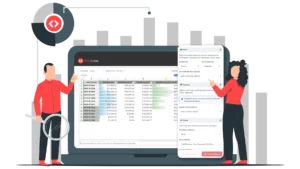Summary
- Economic conditions, travel costs, consumer confidence, and seasonal demand impact bookings during a downturn.
- Adopt revenue management strategies like tracking KPIs, adjusting pricing, offering discounts, and optimizing rates with dynamic pricing.
- Attract more bookings by improving SEO, choosing the right booking channels, and being present on multiple OTAs for increased visibility.
- Use tools like PriceLabs for informed decision-making on pricing.
- Provide exceptional amenities and services to encourage repeat bookings and positive reviews.
According to a report by Grand View Research, the US vacation rental market was valued at $57.7 billion in 2020 and is expected to reach $124.2 billion by 2027. The growth results from the increasing popularity of vacation rentals among travelers, the rise of online booking platforms, and the development of the sharing economy. However, at the moment, the US is at a 50% risk of falling into a recession, and Europe is nearer to 60% or 70%, which can affect the vacation rental market and revenue management strategies.
Revenue management strategies such as optimizing pricing, using targeted marketing to generate demand, and adjusting inventory controls will help vacation rental owners and managers better position themselves for success in varying market conditions. This blog post will cover vacation rental revenue management strategies you can follow in case of an economic slowdown in the US market.
Why is Dynamic Pricing a powerful weapon during booking draught?
Dynamic Pricing allows vacation rental businesses to adjust their prices in real time based on market conditions; maximizing revenue, balancing supply and demand, and maintaining a competitive advantage. By being flexible and responsive to fluctuations in demand, dynamic pricing helps optimize occupancy rates, adapt to changing consumer behavior, and navigate economic downturns more effectively.
Factors affecting vacation rental revenue during an economic downturn
During an economic slowdown, factors like the state of the economy, cost of travel, consumer confidence, and seasonal demand can impact the demand for vacation rentals. The uncertainty in the market and a decrease in consumer spending can lead to a decline in bookings. Inflation rates can also affect pricing strategies for vacation rental companies.
Revenue management strategies during an economic slowdown
1. Define the key performance indicators you want to measure for your revenue management strategies:
- Booking Window: The booking window refers to when a customer makes a reservation and their check-in date. A shorter booking window typically indicates a higher demand and more likelihood of selling out. A longer booking window may show lower demand or more competition in the market. If bookings are slow and the booking window is longer than usual, offering last-minute discounts can encourage guests to book, thereby increasing the occupancy rate.
- Length of Stay (LOS): Length of stay or LOS refers to the number of nights a customer stays in a vacation rental property. Analyzing LOS patterns by season and lead time can help vacation rental owners and managers optimize pricing and inventory control.
- Revenue per Available Room (RevPAR): RevPAR is calculated by dividing the average daily rate by the total number of rooms booked. By tracking RevPAR, vacation rental owners and managers can gain insights into their rental properties’ overall profitability and be aware of how an economic slowdown affects them.
- Average Daily Rate (ADR): Average Daily Rate or ADR is calculated by dividing the total room revenue by the total booked nights. By analyzing ADR, vacation rental owners and managers can optimize pricing strategies to maximize revenue.
- Occupancy: Occupancy is calculated by dividing the number of occupied rooms by the total number of available rooms. By analyzing occupancy rates, vacation rental owners and managers can determine if their rental properties are utilized to their fullest potential and adjust pricing and/or LOS requirements to account for booking changes if necessary.
Tracking these KPIs will provide the foundation for your revenue management strategies for an economic downturn.
2. Analyze the market occupancy patterns.
Understanding your market’s occupancy patterns and determining whether a slowdown is specific to your property or the entire market is crucial. PriceLabs Dynamic Pricing software provides insights into your property’s performance metrics.
PriceLabs’ Neighborhood Data and Market Dashboards features help analyze competition, track KPIs specific to your property, and understand historical and future occupancy trends to gain insights into market demand and adjust pricing strategies effectively.
.
Suppose your property’s occupancy rates are declining, but the overall market demand remains consistent. In that case, you may need to reassess your pricing strategies and look for opportunities to make your property more competitive. This could involve adjusting your base price, minimum price, and discounting strategies to better align with market trends.
3. Optimize rates with dynamic pricing strategies:
Analyze historical data, competitor rates, and market trends to determine the best nightly rate for each rental property. You should also continuously review your base, minimum, and maximum prices.
When using PriceLabs, your base price is the starting point for dynamic pricing strategies. It can be adjusted based on market trends and guest behavior to optimize revenue and occupancy. Setting minimum prices is crucial to avoid accepting bookings below your desired value.
Analyze your competition through custom comp sets or in the Neighborhood Data to determine your property’s competitive base price and minimum price. Ideally, your minimum price is 20-30% less than your base price. Your base price is the average rate across the year for your listing.
You can use the PriceLabs Base Price Help Tool to help calculate a base price for your property. PriceLabs already accounts for seasonality, demand, and lead time when pricing your property. However, if recessionary pressure exists, you may want to adjust your base, minimum, and maximum price slightly. Using seasonal and far-out minimums is a way to allow prices to drop while still maintaining a minimum cost. Seasonal minimums adjust the minimum price according to the seasons you have defined. Far-out minimums adjust the price according to how far out the booking is made.
4. Using Stay Restrictions for your revenue management strategies
The MinStay Recommendation Engine suggests different minimum stay restrictions for multiple booking windows based on how bookings are made in your market for similar properties.
You can use advanced options such as orphan gaps and adjacent day settings to create customized minstay profiles. It’s essential to analyze seasonality and the demand in your market. This ensures you’re using suitable minimum stay restrictions for your property.
Mid-term stays can offer a potential revenue stream during low seasons or economic slowdowns. However, analyze the demand and pricing strategies of mid-term stays in your market before making any decisions.
Using overrides for the lowest stat can help adjust restrictions for specific dates, such as holidays or events. This can help maximize revenue during high-demand periods while maintaining a reasonable minimum stay restriction during low seasons.
5. Offering discounts and promotions to attract bookings:
Offering discounts to past guests can help maintain loyalty and increase repeat business.
You can offer discounts through personalized email campaigns or OTAs. You can also follow these discount strategies to optimize your pricing for an economic slowdown:
- Adjusting discounts for orphan gaps or weekdays with no bookings can help maintain occupancy rates during an economic slowdown. This can include offering deals or promotions for weekdays or adjusting minimum stay requirements for gaps and weekdays.
- Last-minute discounts can also attract bookings and maintain occupancy rates during an economic downturn. PriceLabs offers last-minute pricing strategies that automatically adjust prices based on lead time.
- PriceLabs Occupancy-based Adjustment and Portfolio Occupancy Based Adjustment (POBA) features allow you to set certain price adjustments based on the average occupancy of groups of listings within different time windows.
- Adjusting rates based on demand is a pricing strategy that considers the level of demand for a property or unit when setting the daily rate.
6. Channel management and diversification:
Improving the search engine optimization (SEO) of your listing can make it more visible during booking droughts. This involves optimizing your property description and including relevant keywords that potential guests might search for when looking for a vacation rental in your market.
It’s also important to consider which online travel agencies (OTAs) or booking channels you promote your properties on. You may want to attract mid-term bookings, or a particular booking channel may be popular in your market. Ensure that you’re on the right channel where you attract the right bookings. It’s also a good idea to be present on multiple OTAs to increase your visibility and reach.
7. Utilizing data analysis and forecasting tools to stay informed:
Data analysis and forecasting tools can help property owners make informed decisions about pricing, marketing, and operations during an economic slowdown. PriceLabs provides market insights and demand forecasts for the vacation rental industry. Keeping a close watch on market data trends and adjusting prices quickly and nimbly is the key to success.
With Market Dashboards, you can create customized comp sets to analyze more metrics of your market. You can also use Portfolio Analytics to pace your listing against the market and the previous year’s performance. This can help property owners make data-driven decisions and adjust their revenue management strategies accordingly.
8. Enhancing the guest experience to increase repeat bookings:
Providing an exceptional guest experience to encourage repeat bookings and generate positive reviews is essential during an economic downturn. This can include providing amenities such as high-speed internet, smart TVs, and quality bedding.
Conclusion
There will always be some external circumstances that are out of your control, like an economic recession, a global pandemic, or a natural disaster. Adapting to market changes and utilizing revenue management strategies, vacation rental companies can weather economic uncertainty and emerge stronger.
You hold the key to future-proofing your vacation rental business by leveraging data to eliminate the pricing guesswork.
Frequently asked questions:
1. How do you manage a vacation rental during an economic downturn?
To manage a recession as a vacation rental manager or owner, it is important to:
- closely monitor market trends
- adjust pricing strategies to remain competitive
- optimize occupancy rates by targeting new customer segments or partnering with corporate clients
- enhance the guest experience to differentiate from competitors
- expand marketing efforts to reach a wider audience
- review expenses for potential savings
- focus on guest retention through incentives and personalized experiences
- stay flexible in adapting to market conditions, and build strong relationships with industry partners
2. How do you grow revenue for your vacation rental during a recession?
To grow revenue for your vacation rental during a recession, focus on competitive pricing by adjusting rates while maintaining profitability. Target new markets that may be less affected by the economic downturn, and highlight the unique value of your vacation rental. Offer extended stay options, collaborate with partners for cross-promotion, optimize your online presence, and upsell additional services to increase revenue per booking. Target business travelers, retain and reward repeat guests, and stay adaptable by exploring new revenue streams and innovative offerings. By implementing these strategies, vacation rental businesses can navigate the challenges of a recession and drive revenue growth.








